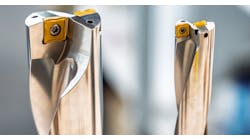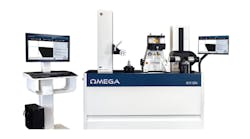Swedish manufacturer Sandvik has a number of diverse businesses under one roof, so to speak, that yield synergies in product development and materials technology.
The Sandvik Group, headquartered in Sandviken, Sweden, consists of six separate business areas responsible for research and development, production, and sales of their respective products. These areas are: Sandvik Tooling, Sandvik Mining and Construction, Sandvik Specialty Steels, Sandvik Hard Materials, Sandvik Saws and Tools, and Sandvik Process Systems.
Sandvik Steel works closely with Sandvik Coromant to improve the machinability of products such as these SANMAC SAF 2205 stainless steel bars.
In a metalworking context, the name Sandvik is typically associated with Sandvik Coromant, the manufacturer of cutting tools and tooling. However, Sandvik is actually comprised of a number of companies, covering such diverse areas as metalcutting and mining. However, what links these companies together is a history and expertise in materials technology that gives each division a unique edge in product development.
Sandvik, which was founded in Sandviken, Sweden, in 1862, started as a steelworks. The company gradually broadened its scope and now manufactures metalcutting tools, specialty steels, ergonomic hand tools and saws, conveyor systems, rock-drilling equipment, and more. The Sandvik Group employs more than 38,000 people in 130 countries, and, in 1997, annual sales topped 40 billion Swedish kroner, or roughly $5 billion.
The company attributes much of its success to shared synergies among its business units. For example, Sandvik Steel has worked with Sandvik Saws and Tools to develop new sawing technologies, and Sandvik Coromant has lent its machining expertise to Sand-vik Steel for new-material testing. Additionally, Sandvik Hard Materials has helped Sandvik Rock Tools develop new tooling for rock-drilling operations.
The metalcutting edge
Sandvik Coromant, an industry leader in cemented-carbide insert technology, introduces roughly 1,000 new products or variants every year. The company reports that 50% of its sales are generated from products less than 5 years old. That's a pretty hefty sum when you consider that last year it raked in over 8 billion Swedish kroner in sales.
Part of the reason that Sandvik Coromant is able to turn out new products so quickly is its relation-ship with Sandvik Steel. According to Annika Roos, marketing manager of Sandvik Steel, "We do about 50% of our research work and about 50% of our product development with Coromant."
Obviously, machinability of metals is important to both companies. Tomas Thorvaldsson, R&D manager of Sandvik Steel, says, "For a good product, you need a good familiarity with tool and material development. Working together helps both parties better understand how materials are affected during the cutting process."
While collaborating, the two can simultaneously develop new materials and the dedicated cutting-tool geometries or grades that optimize machining.
For example, Sandvik Steel recently introduced a new grade of SANMAC stainless steel that exhibits excellent machinability characteristics and increases tool life. Coromant also launched a new insert that it calls the T-Max Wiper. This insert not only optimizes cutting the SANMAC stainless, but it also produces smooth surface finishes at high feedrates on other materials.
Materials development
Before Sandvik Steel produces a new material, it first conducts extensive full-scale production trials and testing in Sandvik's Steel Research and Development Center. This laboratory houses equipment for exploring the microstructure of materials and for checking their chemical structure along with mechanical and physical properties.
As one of the world's largest manufacturers of seamless stainless tube, Sandvik works to better understand materials so customers can then use this knowledge and optimize their machining or welding operations. The R&D center's department of physical metallurgy analyzes the connection between the microstructure of a material—in this case stainless tube—and its properties. The material then undergoes testing in the department's corrosion laboratory and high-temperature research area.
In the center's department of mechanical metallurgy, researchers look at the mechanical strength of Sandvik materials— including tensile strength, hardness, toughness, and fatigue strength. Besides housing a welding lab for R&D of welding consumables, this department has a machining lab where Sandvik Steel works to improve machinability of its grades for all cutting combinations and to predict tool wear from one batch to the next. Development in this laboratory operates in a partnership with Sandvik Coromant.
Synergies beyond products
Cooperation among the Sandvik businesses extends beyond product R&D. It also encompasses the workforce. In 1989, Sandvik Saws and Tools drew up new guidelines for working at its product center in Bollnäs, Sweden. Management wanted to eliminate costly rework, reduce production stocks, and eliminate redundancies in plant operation. Workers wanted to develop new work tasks, improve the working environment, and remove barriers between management and workers. Together they created a new organizational structure called a "flow group."
A typical flow group consists of a small number of workers responsible for a given product on the shop floor. Members take an active role in how the groups are organized, deciding work tasks, priorities, working hours, and more.
The focus of each group is to reduce lead times and increase productivity. As a result, these flow groups have eliminated departments such as quality assurance, assembly, and planning. The functions of these departments have been assumed by the small groups that now oversee every step in production.
The flow group idea has now spread to Sandvik's other business units. About three years ago, Sandvik Coromant's Gimo production facility, which employs 1,360 workers and produces more than 17,000 standard and special items a year, started its own flow groups. And what started at Gimo has now spread to Coromant's other production facilities around the world.
It is interesting to note that Gimo has to produce accurate inserts in small batches, so automation is essential in every aspect of the facility. Therefore, the facility is completely computerized. In addition, it houses unique machines of Sandvik's own design as well as a number of state-of-the-art work-cells that feature equipment such as 5-axis machining centers, robots, grinding machines, and more. However, as important as these sophisticated systems are to Gimo's operations, what Coromant brags about is its people.
According to Coromant President Lars Pettersson, "From an organizational point of view, we have seen improvements in productivity from flow groups that are at least as big as the increases in productivity we've seen from investments in capital equipment. For example, we were able to cut lead times to produce tooling from 50 days to just 12 days. In the carbide area, we cut lead times to 2.5 days." He adds that improvements have varied from group to group and from product to product, but "there are many areas where we've seen productivity increases of 200% to 300%."
Obviously, Sandvik is happy with the flow group concept. And, when asked, the workers do not hesitate to sing their praises. Explains Kjel Söderhäll, vice president Gimo plant, "We decide what work to do, and in what priority. Since we're all culpable, we all want to do a good job. Production is up, and the work-ers are very satisfied."
New products and projects at Coromant
CoroMill 390, which will be introduced at IMTS 98, is an indexable endmill that features a concave cutting edge that cuts a true 90° shoulder. The insert can handle both roughing and finishing operations, including open and closed slotting, edging, face and cavity milling, steep ramping, and plunge milling.
Sandvik Coromant will be introducing a new indexable end mill at IMTS 98. According to Coromant, the CoroMill 390 matches the precision of a solid carbide tool. It was designed to be a multifunction tool capable of both roughing and finishing operations — open and closed slotting, edging, face and cavity milling, steep ramping, and plunge milling.
"Indexable endmills have generally been regarded as a cheap method of removing excess material in small areas," says John Weston, product engineer for milling and drilling tools.
"We wanted to design and develop an indexable endmill that could make a true 90° shoulder, without burrs or mismatch. We also wanted a good surface finish, and what we designed is a product not normally associated with indexable-type tools."
The endmill's design is the key to its performance, explains Per Nilsson, product manager. Rather than a straight edge, the insert features a concave cutting edge that is optimized to the axial and radial dimensions to ensure that the insert maintains accuracy all along the cutting edge. This guarantees the true 90° shoulder, he says.
In the tooling arena, Coromant is working on a research project with Boeing and the University of Aachen to specify real values for every individual component in a tooling assembly. "The reason for this project," explains Andy Pitsker, product manager of Sandvik Inc., Fair Lawn, N.J., "is that once the cutting tool has come in contact with a workpiece material, it is technically out of balance." He adds, "Holding is more a concern in rotating tools — where you have to deal with the dynamics of balance and stiffness of the tool — because the longer tools get, the more problems you face."
Along with its product development efforts, Coromant has simplified tooling selection through its CoroKey program and provided training services to its customers. Says Coromant President Lars Pettersson, "Our customers are getting more dependent on us for training, and, so we've done a number of things. We've hired more specialists and built more training centers. We offer in-house training along with a published, comprehensive book on metalworking, a number of guidebooks, and the world's largest metalcutting magazine. In addition, we're expanding our website to include access to all our cutting tools and the capability to download 3D CAD files."
The many faces of the Sandvik Group
Coromant Capto modular tooling can be used for turning, milling, drilling, and boring. The tooling incorporates a special tapered polygon coupling that is pre-tensioned in the clamping unit with a clamping force of several tons. This lets the tooling's large contact surface transfer huge torques in both directions with no slip providing stability and repeatability.
Sandvik Saws and Tools has developed a new tooth form for its 3854 King Cobra bi-metal bandsaw blade. Called PH, the new design features repeating groups of varying-pitch teeth to saw through tough materials such as hard tool and mold steels and hard alloy and exotic metals. The 3854 PH is available in both coils and welded loops.
Tamrock's top hammer division makes mining equipment used for tunneling, bolting, and production and bench drilling. Tamrock works closely with Sandvik Rock Tools, which makes cemented-carbide rock cutting tools. Here, a Tamrock top hammer uses a Sandvik Rock Tool drill (left) to make test holes in a cave wall.
Sandvik Tooling manufactures cutting tools, tooling, and support systems for metal cutting. The two sectors of this business include Sandvik Coromant Inc. and the CTT Tools Group, which is represented by Dormer Tools Inc. and Union Butterfield Corp. in the U.S.
Sandvik Steel Co. produces tube, strip, wire, and bar stock in stainless and high-alloy steels. It also manufactures titanium and zirconium tubing.
Sandvik Process Systems Inc. supplies turnkey automatic high-speed sorting systems and continuous steel belts.
Sandvik Saws and Tools manufactures saws and saw blades as well as hand tools.
Sandvik Hard Materials Co. makes cemented-carbide blanks and customer-specific wear parts and hot rolls in cemented carbide. In addition, it produces PCD and PCBN blanks for toolmakers.
Sandvik Rock Tools Inc. makes cemented-carbide tipped rock drilling tools for mining, civil engineering, and water-well drilling.
Tamrock Corp. Sandvik recently acquired Tam-rock, which makes construction and excavation equipment. Tamrock's main production facility, located in Tampere, Finland, turns out production drilling rigs, surface drilling rigs, tunneling and drifting jumbos, and rock reinforcement equipment.






